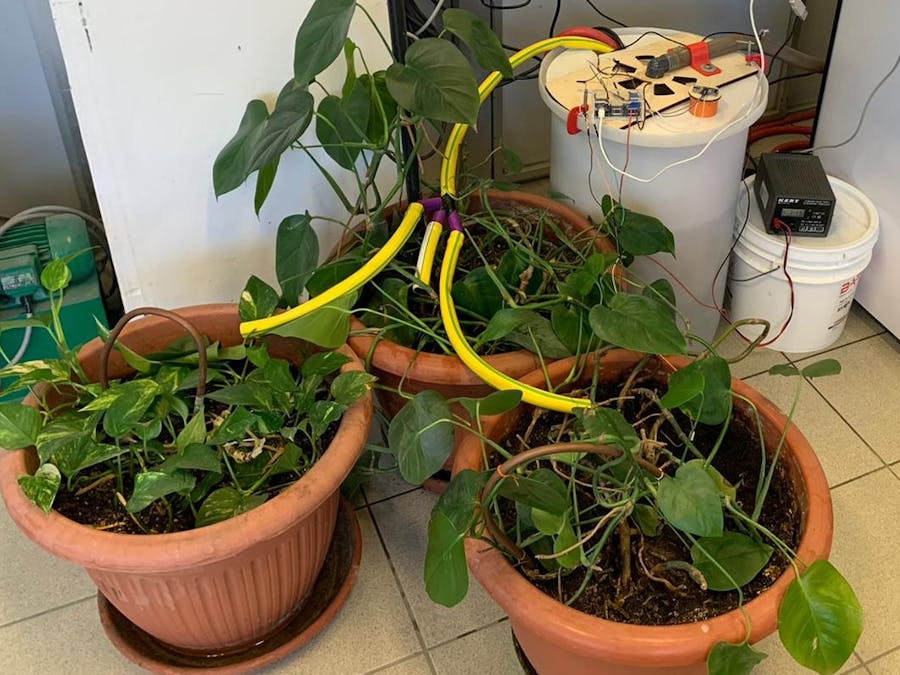#define BLYNK_PRINT Serial
#include <ESP8266WiFi.h>
#include <BlynkSimpleEsp8266.h>
#include <SPI.h>
#include <Wire.h>
#define PIN_UPTIME V5 //blynk virtual pin variable (V5)
#define VOLUME V7 //blynk virtual pin variable (V7)
#include <NewPingESP8266.h>
#define TRIGGER_PIN D2 // esp8266 pin tied to trigger pin on the ultrasonic sensor.
#define ECHO_PIN D3 // esp8266 pin tied to echo pin on the ultrasonic sensor.
#define MAX_DISTANCE 200 // Maximum distance we want to ping for (in centimeters). Maximum sensor distance is rated at 400-500cm.
NewPingESP8266 sonar(TRIGGER_PIN, ECHO_PIN, MAX_DISTANCE); // NewPingESP8266 setup of pins and maximum distance.
int distance = 0;
const int AirValue = 1000; //you need to replace this value with Value_1, air humidity value
const int WaterValue = 0 ; //you need to replace this value with Value_2, water humidity value
const int SensorPin = A0; //esp8266 pin tied to humidity sensor
int soilMoistureValue = 0;
int soilmoisturepercent = 0;
char auth[] = "xx"; //token used for blynk
char ssid[] = "xx"; //wifi name
char pass[] = "xx"; //wifi password
int h = 0;
BLYNK_READ(PIN_UPTIME)
{
Blynk.virtualWrite(PIN_UPTIME, h); // This command writes esp8266's uptime in seconds to Virtual Pin (5)
}
BLYNK_READ(VOLUME)
{
Blynk.virtualWrite(PIN_UPTIME, distance); // This command writes esp8266's uptime in seconds to Virtual Pin (7)
}
#include <ESP8266WiFi.h>
#include <WiFiClientSecure.h>
#include <UniversalTelegramBot.h> // Universal Telegram Bot Library written by Brian Lough: https://github.com/witnessmenow/Universal-Arduino-Telegram-Bot
#include <ArduinoJson.h>
const char* password = "xx";
#define CHAT_ID "331694920"// Initialize Telegram BOT
#define BOTtoken "1700865436:AAGG8dl_pG1SeuTMQfEZP-cYsR80Zlg8R-o" // your Bot Token (Get from Botfather)
WiFiClientSecure client;
UniversalTelegramBot bot(BOTtoken, client);
int botRequestDelay = 1000; //Checks for new messages every 1 second.
unsigned long lastTimeBotRan;
const int relayPin = D1;
bool relayPinstate = LOW;
void setup() {
pinMode(relayPin, OUTPUT);
Blynk.begin(auth, ssid, pass);
Serial.begin(9600);
Wire.begin();
client.setInsecure();
WiFi.mode(WIFI_STA); // Connect to Wi-Fi
WiFi.begin(ssid, password);
while (WiFi.status() != WL_CONNECTED) {
delay(1000);
Serial.println("Connecting to WiFi..");
}
Serial.println(WiFi.localIP()); // Print Local IP Address
pinMode(relayPin, OUTPUT);
digitalWrite(relayPin, relayPinstate);
}
void loop()
{
Blynk.run();
soilMoistureValue = analogRead(SensorPin); //put Sensor insert into soil
soilmoisturepercent = map(soilMoistureValue, AirValue, WaterValue, 0, 100); //mapping the value from the sensor
if (soilmoisturepercent > 100)
{
Serial.println("100 %");
h = 100;
}
else if (soilmoisturepercent < 0)
{
Serial.println("0 %");
h = 0;
}
else if (soilmoisturepercent >= 0 && soilmoisturepercent <= 100)
{
Serial.print(soilmoisturepercent);
Serial.println("%");
h = soilmoisturepercent;
}
Blynk.virtualWrite(PIN_UPTIME, h); //write h on the virtual pin
delay(500); // Wait 50ms between pings (about 20 pings/sec)
distance = sonar.ping_cm();
Serial.print( " distance:");
Serial.println(distance);
distance = (distance * 1075.21) / 1000; //(Raggio^2*pigreco*h)/1000, turn distance into volume
distance = (38 - distance); //38 is the total volume of the bucket
Blynk.virtualWrite(VOLUME, distance); //write VOLUME on the virtual pin
if (h > 50 && distance >= 5) {
if (millis() > lastTimeBotRan + botRequestDelay) {
int numNewMessages = bot.getUpdates(bot.last_message_received + 1);
while (numNewMessages) {
Serial.println("got response");
handleNewMessages(numNewMessages);
numNewMessages = bot.getUpdates(bot.last_message_received + 1);
}
lastTimeBotRan = millis();
}
}
if (h <= 50 && distance >= 5)
{
relayPinstate = HIGH;
digitalWrite(relayPin, relayPinstate);
delay (5000);
relayPinstate = LOW;
digitalWrite(relayPin, relayPinstate);
if (soilmoisturepercent > 100)
{
Serial.println("100 %");
h = 100;
}
else if (soilmoisturepercent < 0)
{
Serial.println("0 %");
h = 0;
}
else if (soilmoisturepercent >= 0 && soilmoisturepercent <= 100)
{
Serial.print(soilmoisturepercent);
Serial.println("%");
h = soilmoisturepercent;
}
distance = sonar.ping_cm();
Serial.print( " distance:");
Serial.println(distance);
distance = (distance * 1075.21) / 1000; //(Raggio^2*pigreco*h)/1000, turn distance into volume
distance = (38 - distance); //38 is the total volume of the bucket
Blynk.virtualWrite(VOLUME, distance); //write VOLUME on the virtual pin
String data = "WATER " + String(distance) + "L, HUMIDITY" + String(h) + "%";
bot.sendMessage(CHAT_ID, data);
}
}
void handleNewMessages(int numNewMessages) { // Handle what happens when you receive new messages
Serial.println("handleNewMessages");
Serial.println(String(numNewMessages));
for (int i = 0; i < numNewMessages; i++) {
// Chat id of the requester
String chat_id = String(bot.messages[i].chat_id);
if (chat_id != CHAT_ID) {
bot.sendMessage(chat_id, "Unauthorized user", "");
continue;
}
String text = bot.messages[i].text; // Print the received message
Serial.println(text);
String from_name = bot.messages[i].from_name;
if (text == "/start") {
String welcome = "Welcome, " + from_name + ".\n";
welcome += "Use the following commands to control your outputs.\n\n";
welcome += "/relay_on to turn GPIO ON \n";
welcome += "/relay_off to turn GPIO OFF \n";
bot.sendMessage(chat_id, welcome, "");
}
if (text == "/relay_on") {
bot.sendMessage(chat_id, "RELAY state set to ON", "");
relayPinstate = HIGH;
digitalWrite(relayPin, relayPinstate);
}
if (text == "/relay_off") {
bot.sendMessage(chat_id, "RELAY state set to OFF", "");
relayPinstate = LOW;
digitalWrite(relayPin, relayPinstate);
}
}
}












_t9PF3orMPd.png?auto=compress%2Cformat&w=40&h=40&fit=fillmax&bg=fff&dpr=2)






_3u05Tpwasz.png?auto=compress%2Cformat&w=40&h=40&fit=fillmax&bg=fff&dpr=2)
Comments